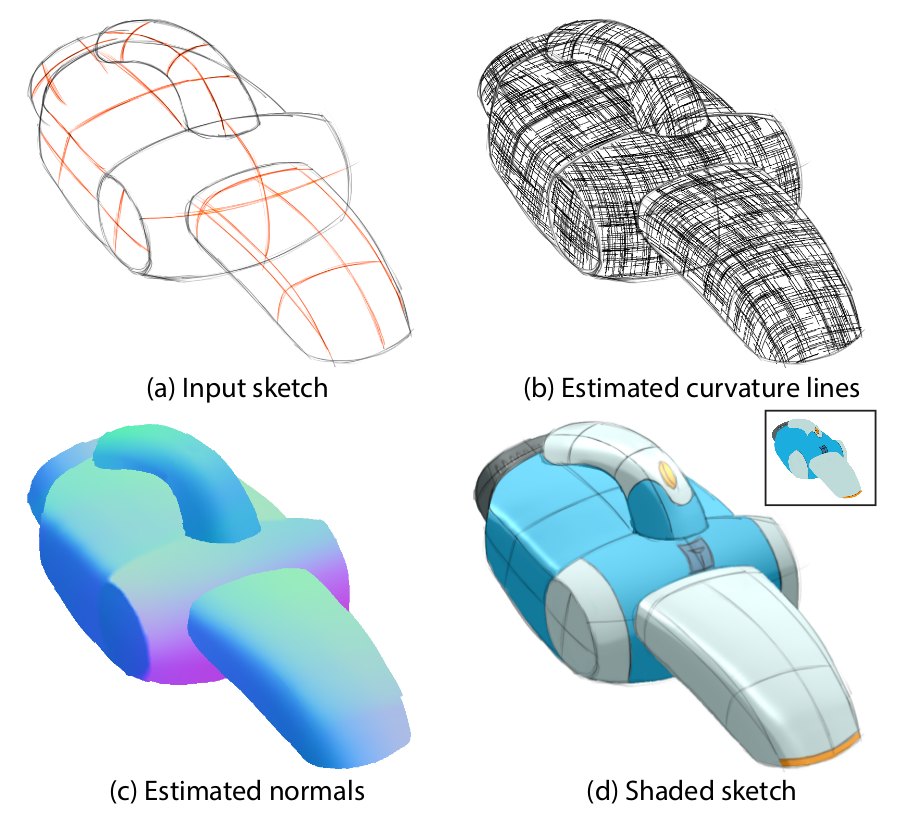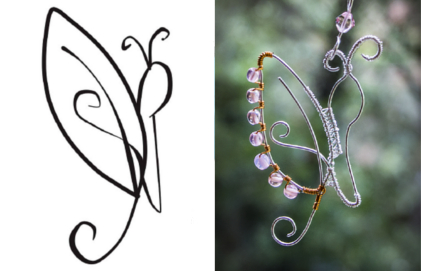Section: New Results
Computer-Assisted Design with Heterogeneous Representations
BendFields: Regularized Curvature Fields from Rough Concept Sketches
Participants : Adrien Bousseau, Emmanuel Iarussi.
Designers frequently draw curvature lines to convey bending of smooth surfaces in concept sketches. We present a method to extrapolate curvature lines in a rough concept sketch, recovering the intended 3D curvature field and surface normal at each pixel of the sketch (Fig. 4 ). This 3D information allows us to enrich the sketch with 3D-looking shading and texturing. We first introduce the concept of regularized curvature lines that model the lines designers draw over curved surfaces, encompassing curvature lines and their extension as geodesics over flat or umbilical regions. We build on this concept to define the orthogonal cross field that assigns two regularized curvature lines to each point of a 3D surface. Our algorithm first estimates the projection of this cross field in the drawing, which is non-orthogonal due to foreshortening. We formulate this estimation as a scattered interpolation of the strokes drawn in the sketch, which makes our method robust to sketchy lines that are typical for design sketches. Our interpolation relies on a novel smoothness energy that we derive from our definition of regularized curvature lines. Optimizing this energy subject to the stroke constraints produces a dense non-orthogonal 2D cross field, which we then lift to 3D by imposing orthogonality. Thus, one central concept of our approach is the generalization of existing cross field algorithms to the non-orthogonal case. We demonstrate our algorithm on a variety of concept sketches with various levels of sketchiness. We also compare our approach with existing work that takes clean vector drawings as input.
This work is a collaboration with David Bommes from Titane project team at Inria Sophia-Antipolis, now at RWTH Aachen University. It has been published at ACM Transactions on Graphics (TOG) [7] .
|
Line Drawing Interpretation in a Multi-View Context
Participant : Adrien Bousseau.
Many design tasks involve the creation of new objects in the context of an existing scene. Existing work in computer vision only provides partial support for such tasks. On the one hand, multi-view stereo algorithms allow the reconstruction of real-world scenes, while on the other hand algorithms for line-drawing interpretation do not take context into account. Our work combines the strength of these two domains to interpret line drawings of imaginary objects drawn over photographs of an existing scene (Fig. 5 ). The main challenge we face is to identify the existing 3D structure that correlates with the line drawing while also allowing the creation of new structure that is not present in the real world. We propose a labeling algorithm to tackle this problem, where some of the labels capture dominant orientations of the real scene while a free label allows the discovery of new orientations in the imaginary scene. We illustrate our algorithm by interpreting line drawings for urban planing, home remodeling, furniture design and cultural heritage.
This work is a collaboration with Jean-Dominique Favreau and Florent Lafarge from Titane project team, Inria Sophia-Antipolis. It has been published at the Conference on Computer Vision and Pattern Recognition (CVPR) [14] .
|
WrapIt: Computer-Assisted Crafting of Wire Wrapped Jewelry
Participants : Adrien Bousseau, Emmanuel Iarussi.
Wire wrapping is a traditional form of handmade jewelry that involves bending metal wire to create intricate shapes. The technique appeals to novices and casual crafters because of its low cost, accessibility and unique aesthetic. We present a computational design tool that addresses the two main challenges of creating 2D wire-wrapped jewelry: decomposing an input drawing into a set of wires, and bending the wires to give them shape (Fig. 6 ). Our main contribution is an automatic wire decomposition algorithm that segments a drawing into a small number of wires based on aesthetic and fabrication principles. We formulate the task as a constrained graph labeling problem and present a stochastic optimization approach that produces good results for a variety of inputs. Given a decomposition, our system generates a 3D-printed custom support structure, or jig, that helps users bend the wire into the appropriate shape. We validated our wire decomposition algorithm against existing wire-wrapped designs, and used our end-to-end system to create new jewelry from clipart drawings. We also evaluated our approach with novice users, who were able to create various pieces of jewelry in less than half an hour.
This work is a collaboration with Wilmot Li from Adobe, San Francisco. The project was initiated by a 3-months visit of Emmanuel Iarussi at Adobe. It has been published at ACM Transactions on Graphics (Proc. SIGGRAPH Asia) [8] .
|
How Novices Sketch and Prototype Hand-Fabricated Objects
Participant : Adrien Bousseau.
We are interested in how to create digital tools to support informal sketching and prototyping of objects by novices. Achieving this goal first requires a deeper understanding of how novices currently generate, explore, and communicate design ideas with traditional tools, i.e., sketches on paper and hands-on prototyping materials. We describe a study framed around two all-day design charrettes where participants perform a complete design process including ideation sketching, concept development and presentation, fabrication planning documentation and collaborative fabrication of hand-crafted prototypes. This structure allows us to control key aspects of the design process while collecting rich data about creative tasks, including sketches on paper, physical models, and videos of collaboration discussions. We observed that while participants had no formal training in design, they made use of advanced visualization techniques to convey 3D concepts. Participants also extensively used physical materials (paper, foam, cardboard) both to support concept exploration and to communicate their ideas to collaborators. We deduce from these observations recommendations for the conception of design tools adapted to the needs and skills of novices.
This work is a collaboration with Wendy McKay, Theophanis Tsandilas and Lora Oehlberg from the InSitu project team - Inria Saclay, in the context of the ANR DRAO project. It is conditionally accepted to ACM CHI 2016.
Vectorizing Rough Line Drawings
Participant : Adrien Bousseau.
Our goal in this project is to convert rough, freehand bitmap sketches to clean vector drawings, keeping three main objectives in mind: (i) the vectorial curves should approximate well the input drawing, (ii) the drawing should be composed of a small number of curves with few control points to preserve the compactness and editability of vector graphics, and (iii) the algorithm should support user guidance to disambiguate the multiple interpretations inherent to artistic inputs. Unfortunately, existing vectorization algorithms only partly satisfy these requirements. In particular, while most methods employ curve fitting to satisfy the first objective of data fidelity, this fitting is performed locally and is often sub-optimal with respect to our second objective of low complexity. To achieve our objectives, we propose to cast line drawing vectorization as a global optimization that balances data fidelity with model complexity. We express data fidelity as the goodness of fit of Bézier curve segments, and we express model complexity as the number and degree of curve segments that compose the output drawing. Our algorithm produces clean, compact and editable vector drawings from bitmap sketches.
This ongoing work is a collaboration with Jean-Dominique Favreau and Florent Lafarge from Titane project team, Inria Sophia-Antipolis.
Exploring Design Spaces with Sketch-Based Rendering
Participant : Adrien Bousseau.
Designers often start product design by drawing many quick and imperfect sketches. These sketches typically capture shape variations of a concept from different viewpoints. We introduce sketch-based rendering as a way to help designers explore the design space induced by such sketches. Our interactive tool allows designers to interpolate between the sketches, providing a continuous, 3D-like visualization of the concept and its variations without requiring explicit 3D information.
We propose an iterative algorithm to match and warp between sketches using little user interaction. We designed this algorithm to address the specific challenges inherent to concept sketches, in particular the fact that they are dominated by contours rather than color or texture, and that these contours should not distort during interpolation. We also describe how to approximate the relative camera positions of different sketches from the magnitude of their 2D motion fields. This approach allows plausible 3D-like camera movements despite the presence of sketch distortions and variations that prevent standard camera calibration. Our tool, thus, fills a gap in the initial stage of the product design pipeline by allowing designers and their patrons to make better informed choices before proceeding to more expensive 3D modeling and prototyping.
This ongoing work is a collaboration with Ishan Darolia and Vinay Namboodiri from IIT Kampur and Rahul Arora and Karan Singh from University of Toronto.
Sketch-Based Inverse Procedural Modeling
Participant : Adrien Bousseau.
Designing and modeling 3D objects is a crucial skill in various areas of entertainment, science, and engineering. However, this task is notoriously hard and unintuitive, especially for novices. Prior work has addressed the modeling problem from many different directions. Sketch-based modeling exploits human intuition and experience in drawing objects. Nevertheless, the quality of the final 3D model depends on the sketching skills of the user, the amount of details added to the drawing, and ability to resolve inherent ambiguities of the sketching process. Another popular direction is procedural modeling, which has been successfully used to create detailed and complex cities, realistic and growing vegetation, and other man-made objects. But procedural modeling is difficult to control and thus hard to use as an exploratory design tool making it accessible only to experts. Our goal in this project is to leverage both the intuitiveness, freedom and flexibility of sketching and the precision, exactness, and detail amplification of procedural modeling. Users of our system begin to sketch a 3D model using a mouse or a digital pen on a tablet. After only a few strokes, our algorithm finds a compact 3D procedural representation that matches the sketch while augmented it with geometric details.
This ongoing work is a collaboration with Gen Nishida, Bedrich Benes, Ignacio Garcia Dorado and Daniel Aliaga from Purdue University.
A data-based approach to retrieve the viewpoint of a design sketch
Participants : Johanna Delanoy, Adrien Bousseau.
Designing objects requires frequent transitions from a 2D representation, the sketch, to a 3D one. Because 3D modeling is time consuming, it is made only during late phases of the design process. Our long term goal is to allow designers to automatically generate 3D models from their sketches. In this work, we address the preliminary step of recovering the viewpoint under which the object is drawn. We adopt a data-driven approach where we build correspondences between the sketch and 3D objects of the same class from a database. In particular, we relate the curvature lines and contours of the 3D objects to similar lines commonly drawn by designers using histograms of orientation. The 3D objects from the database are then used to vote for the viewpoints and the more probable ones are chosen. Our results on design sketches suggest that using both contours and curvature lines give higher precision than using either one. In particular, curvature information improves viewpoint retrieval when details of the objects are different from the sketch.
The work has been published in the journal Revue Française d'Informatique Graphique and presented at the 28th Journées de l'Association Française d'Informatique Graphique [5] .
|





